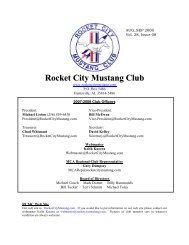2006 Ford Racing Performance Parts Catalog - Rocket City Mustang ...
2006 Ford Racing Performance Parts Catalog - Rocket City Mustang ...
2006 Ford Racing Performance Parts Catalog - Rocket City Mustang ...
You also want an ePaper? Increase the reach of your titles
YUMPU automatically turns print PDFs into web optimized ePapers that Google loves.
BIG BLOCK V-8 ENGINES<br />
429/429CJ/429SCJ/429 BOSS/460<br />
During The Golden Age of Muscle, high<br />
performance versions of 429/460 engines<br />
flashed on the scene like a firefly. The glow<br />
was brief—from 1969 to 1971. The memory<br />
lingers on. All of those cubic inches! Never<br />
again available directly from the factory ready<br />
for competition. Luckily, engines and pieces<br />
are still around. There are several ways to go,<br />
depending on the performance level you want,<br />
be it simply a Bracket Drag Racer, or something<br />
more potent, like an offshore power boat,<br />
big torquing engine for truck pulls or a Pro Stock<br />
drag machine. Here’s a brief description of<br />
production engines to give you an idea of part<br />
interchangeability and general performance level.<br />
429/460<br />
The 429 “Thunder Jet” was introduced in 1968.<br />
It’s your basic passenger car “wedge” engine<br />
design with hydraulic cam, 2-bolt main caps,<br />
and either 2V or 4V carburetor. Cast iron “rail”<br />
rocker arms are mounted on non-adjustable,<br />
positive stop studs (1968-72). 1973 and later<br />
429/460 engines use pedestal-mount<br />
rocker arms as described for 351C engines<br />
on page 225. The 460 is a stroked version<br />
of the 429. With modifications, these engines<br />
can be used for most competition, except<br />
offshore boats or with a supercharger.<br />
429CJ (COBRA JET)<br />
Take a base 429, then add a hotter hydraulic<br />
cam, larger CFM carburetor, heads with bigger<br />
ports and valves, plus a few other items and<br />
you have a 429CJ. 1970 engines had 2-bolt<br />
mains; 1971 models 4-bolts. Engines built<br />
before 11/1/69 use an adjustable, non-positive<br />
stop rocker arm stud, so a mechanical cam<br />
is easily installed.<br />
429SCJ (SUPER COBRA JET)<br />
Now, we’re talking about an engine you can<br />
modify for serious competition. The 429SCJ<br />
has 4-bolt main caps (#2, #3, and #4 journals),<br />
mechanical cam, adjustable non-positive stop<br />
rocker arm studs, stamped rocker arms and<br />
push rod guide plates. The pistons are forged<br />
aluminum and con rod bolt seats are spot faced.<br />
As with the CJ, production ended in 1971.<br />
429 BOSS<br />
This is an all-out competition design with<br />
aluminum heads and hemi combustion chambers<br />
(technically, they’re “crescent-shaped”). The first<br />
few hundred in 1969 for NASCAR competition<br />
were called “S” engines; the later street version is<br />
a “T” engine. “T” engine con rods are spot faced<br />
for a .375" bolt and hex nut. “S” engine con rods<br />
are beefier, 0.056" shorter, have wider bearing<br />
journals and use a .5" bolt with 12-point nut.<br />
D. Hays<br />
USAC Midget Series<br />
*<br />
www.fordracingparts.com 221




